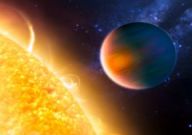Space & Astronomy
August 20, 2013 · 11 comments
11 comments

Image Credit: NASA/ESA
The newly discovered planet has a few other surprises in store as well. It is the first time scientists have been able to directly observe light from a planet of this size and because of its tight orbit, it is believed that it may be possible to determine its mass, a feat never achieved before for a planet outside of our own solar system.
Source: The Register | Comments (11)
Fireball planet orbits star in 8.5 hours
By T.K. RandallAugust 20, 2013 ·
 11 comments
11 comments
Image Credit: NASA/ESA
A newly discovered Earth-sized world around a distant star completes a full orbit in a matter of hours.
Dubbed Kepler 78b, the small world orbits its parent star at a distance 40 times closer than Mercury's orbit of our own sun. Not only does this produce an extremely short orbital period but the planet itself is a smouldering, hellish world with temperatures exceeding 3,000 Kelvin. By contrast, Mercury's maximum surface temperature peaks at around 700 Kelvin.The newly discovered planet has a few other surprises in store as well. It is the first time scientists have been able to directly observe light from a planet of this size and because of its tight orbit, it is believed that it may be possible to determine its mass, a feat never achieved before for a planet outside of our own solar system.
Researchers at the Massachusetts Institute of Technology have discovered a new, Earth-sized exoplanet for which orbiting its star is literally all in a day's work.
Source: The Register | Comments (11)

The Unexplained Mysteries
Book of Weird News
AVAILABLE NOW
Take a walk on the weird side with this compilation of some of the weirdest stories ever to grace the pages of a newspaper.
Click here to learn more

Support us on Patreon
BONUS CONTENTFor less than the cost of a cup of coffee, you can gain access to a wide range of exclusive perks including our popular 'Lost Ghost Stories' series.
Click here to learn more
Other World News
United States and the Americas
Spirituality, Religion and Beliefs
Palaeontology, Archaeology and History
Total Posts: 7,779,036 Topics: 325,614 Members: 203,936
Not a member yet ? Click here to join - registration is free and only takes a moment!
Not a member yet ? Click here to join - registration is free and only takes a moment!



























Please Login or Register to post a comment.